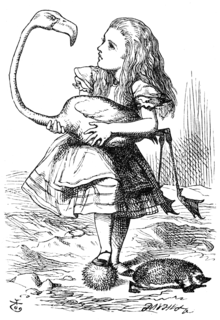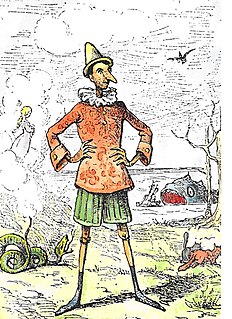Detective fiction is a subgenre of crime fiction and mystery fiction in which an investigator or a detective—either professional, amateur or retired—investigates a crime, often murder. The detective genre began around the same time as speculative fiction and other genre fiction in the mid-nineteenth century and has remained extremely popular, particularly in novels. Some of the most famous heroes of detective fiction include C. Auguste Dupin, Sherlock Holmes, and Hercule Poirot. Juvenile stories featuring The Hardy Boys, Nancy Drew, and The Boxcar Children have also remained in print for several decades.
Nonfiction is any document or media content that intends, in good faith, to present only truth and accuracy regarding information, events, or people. Nonfictional content may be presented either objectively or subjectively. Sometimes taking the form of a story, nonfiction is one of the fundamental divisions of narrative writing — in contrast to fiction, which offers information, events, or characters expected to be partly or largely imaginary, or else leaves open if and how the work refers to reality.

Poetry is a form of literature that uses aesthetic and often rhythmic qualities of language—such as phonaesthetics, sound symbolism, and metre—to evoke meanings in addition to, or in place of, the prosaic ostensible meaning.

In a literary work, film, story or other narrative, the plot is the sequence of events where each affects the next one through the principle of cause-and-effect. The causal events of a plot can be thought of as a series of events linked by the connector "and so". Plots can vary from the simple—such as in a traditional ballad—to forming complex interwoven structures, with each part sometimes referred to as a subplot or imbroglio. In common usage, however, it can mean a narrative summary or story synopsis, rather than a specific cause-and-effect sequence.
In literary criticism, stream of consciousness is a narrative mode or method that attempts "to depict the multitudinous thoughts and feelings which [sic] pass through the mind" of a narrator. The term was coined by Alexander Bain in 1855 in the first edition of The Senses and the Intellect, when he wrote, "The concurrence of Sensations in one common stream of consciousness enables those of different senses to be associated as readily as the sensations of the same sense" (p. 359). But it is commonly credited to William James who used it in 1890 in his The Principles of Psychology. In 1918, the novelist May Sinclair (1863–1946) first applied the term stream of consciousness, in a literary context, when discussing Dorothy Richardson's (1873–1957) novels. Pointed Roofs (1915), the first work in Richardson's series of 13 semi-autobiographical novels titled Pilgrimage, is the first complete stream-of-consciousness novel published in English. However, in 1934, Richardson comments that "Proust, James Joyce, Virginia Woolf & D.R. ... were all using 'the new method', though very differently, simultaneously". There were, however, many earlier precursors and the technique is still used by contemporary writers.
Genre fiction, also known as popular fiction, is a term used in the book-trade for fictional works written with the intent of fitting into a specific literary genre, in order to appeal to readers and fans already familiar with that genre.
A narrative, story or tale is any account of a series of related events or experiences, whether nonfictional or fictional. Narratives can be presented through a sequence of written or spoken words, still or moving images, or any combination of these. The word derives from the Latin verb narrare, which is derived from the adjective gnarus. Along with argumentation, description, and exposition, narration, broadly defined, is one of four rhetorical modes of discourse. More narrowly defined, it is the fiction-writing mode in which the narrator communicates directly to the reader.
Sagas are prose stories and histories, composed in Iceland and to a lesser extent elsewhere in Scandinavia.

A literary genre is a category of literary composition. Genres may be determined by literary technique, tone, content, or even length. They generally move from more abstract, encompassing classes, which are then further sub-divided into more concrete distinctions. The distinctions between genres and categories are flexible and loosely defined, and even the rules designating genres change over time and are fairly unstable.
Narration is the use of a written or spoken commentary to convey a story to an audience. Narration is conveyed by a narrator: a specific person or unspecified literary voice, developed by the creator of the story, to deliver information to the audience, particularly about the plot. Narration is a required element of all written stories, with the function of conveying the story in its entirety. However, narration is merely optional in most other storytelling formats, such as films, plays, television shows, and video games, in which the story can be conveyed through other means, like dialogue between characters or visual action.

In Our Time is Ernest Hemingway's first collection of short stories, published in 1925 by Boni & Liveright, New York. Its title is derived from the English Book of Common Prayer, "Give peace in our time, O Lord". The collection's publication history was complex. It began with six prose vignettes commissioned by Ezra Pound for a 1923 edition of The Little Review; Hemingway added twelve more and in 1924 compiled the in our time edition, which was printed in Paris. To these were added fourteen short stories for the 1925 edition, including "Indian Camp" and "Big Two-Hearted River", two of his best-known Nick Adams stories. He composed "On the Quai at Smyrna" for the 1930 edition.

The iceberg theory or theory of omission is a writing technique coined by American writer Ernest Hemingway. As a young journalist, Hemingway had to focus his newspaper reports on immediate events, with very little context or interpretation. When he became a writer of short stories, he retained this minimalistic style, focusing on surface elements without explicitly discussing underlying themes. Hemingway believed the deeper meaning of a story should not be evident on the surface, but should shine through implicitly.
Fiction writing is the composition of non-factual prose texts. Fictional writing often is produced as a story meant to entertain or convey an author's point of view. The result of this may be a short story, novel, novella, screenplay, or drama, which are all types of fictional writing styles. Different types of authors practice fictional writing, including novelists, playwrights, short story writers, radio dramatists and screenwriters.
A vignette is a short and descriptive piece of writing that captures a brief period in time. Vignettes are more focused on vivid imagery and meaning rather than plot. Vignettes can be stand-alone, but they are more commonly part of a larger narrative, such as vignettes found in novels or collections of short stories.
Traditional stories, or stories about traditions, differ from both fiction and nonfiction in that the importance of transmitting the story's worldview is generally understood to transcend an immediate need to establish its categorization as imaginary or factual. In the academic circles of literature, religion, history, and anthropology, categories of traditional story are important terminology to identify and interpret stories more precisely. Some stories belong in multiple categories and some stories do not fit into any category.

Fiction generally is a narrative form, in any medium, consisting of people, events, or places that are imaginary—in other words, not based strictly on history or fact. In its most narrow usage, fiction refers to written narratives in prose and often specifically novels, though also novellas and short stories. More broadly, fiction has come to encompass imaginary narratives expressed in any form, including not just writings but also live theatrical performances, films, television programs, radio dramas, comics, role-playing games, and video games.

Fan fiction or fanfiction is fictional writing written by fans, based on an existing work of fiction. The author uses copyrighted characters, settings, or other intellectual properties from the original creator(s) as a basis for their writing. Fan fiction ranges from a couple of sentences to an entire novel, and fans can both keep the creator's characters and settings and/or add their own. It is a form of fan labor. Fan fiction can be based on any fictional subject. Common bases for fan fiction include novels, movies, bands, and video games.

Literature broadly is any collection of written work, but it is also used more narrowly for writings specifically considered to be an art form, especially prose fiction, drama, and poetry. In recent centuries, the definition has expanded to include oral literature, much of which has been transcribed. Literature is a method of recording, preserving, and transmitting knowledge and entertainment.

A novel is a relatively long work of narrative fiction, typically written in prose and published as a book. The present English word for a long work of prose fiction derives from the Italian: novella for "new", "news", or "short story of something new", itself from the Latin: novella, a singular noun use of the neuter plural of novellus, diminutive of novus, meaning "new".







